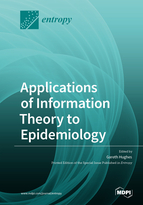Applications of Information Theory to Epidemiology
A special issue of Entropy (ISSN 1099-4300). This special issue belongs to the section "Information Theory, Probability and Statistics".
Deadline for manuscript submissions: closed (30 September 2020) | Viewed by 33478
Special Issue Editor
Special Issue Information
Dear Colleagues,
Epidemiological applications of information theory can be traced back at least as far as the 1970s. The work of W.I. Card (collaborating with I.J. Good) on diagnostic decision-making in terms of entropy reduction and the work of C.E. Metz and colleagues on an information theoretic approach to the interpretation of receiver operating characteristic (ROC) curve data are examples of early applications. Almost half a century on, these examples still typify the way that information theory has been used by many epidemiologists and diagnosticians to gain insight into our understanding of disease risk and our decision-making in relation to the management of risk. At the same time, new applications are appearing, not least in the pages of Entropy.
This Special Issue looks both back at the way information theory has already contributed to our epidemiological understanding of disease risk, and forward to new contributions. Medical and botanical applications are predominant at the moment, but the increasing availability of individual and household data to social geographers and commercial sociologists seems likely to present new opportunities for information theoretic applications. We welcome research work on all aspects of information theoretic applications in the study of epidemiology and disease risk for this Special Issue.
Prof. Dr. Gareth Hughes
Guest Editor
Manuscript Submission Information
Manuscripts should be submitted online at www.mdpi.com by registering and logging in to this website. Once you are registered, click here to go to the submission form. Manuscripts can be submitted until the deadline. All submissions that pass pre-check are peer-reviewed. Accepted papers will be published continuously in the journal (as soon as accepted) and will be listed together on the special issue website. Research articles, review articles as well as short communications are invited. For planned papers, a title and short abstract (about 100 words) can be sent to the Editorial Office for announcement on this website.
Submitted manuscripts should not have been published previously, nor be under consideration for publication elsewhere (except conference proceedings papers). All manuscripts are thoroughly refereed through a single-blind peer-review process. A guide for authors and other relevant information for submission of manuscripts is available on the Instructions for Authors page. Entropy is an international peer-reviewed open access monthly journal published by MDPI.
Please visit the Instructions for Authors page before submitting a manuscript. The Article Processing Charge (APC) for publication in this open access journal is 2600 CHF (Swiss Francs). Submitted papers should be well formatted and use good English. Authors may use MDPI's English editing service prior to publication or during author revisions.
Keywords
- Medical epidemiology
- Botanical epidemiology
- Social geography
- Disease risk factors
- Calibration and validation of risk algorithms
- Diagnostic decision-making







